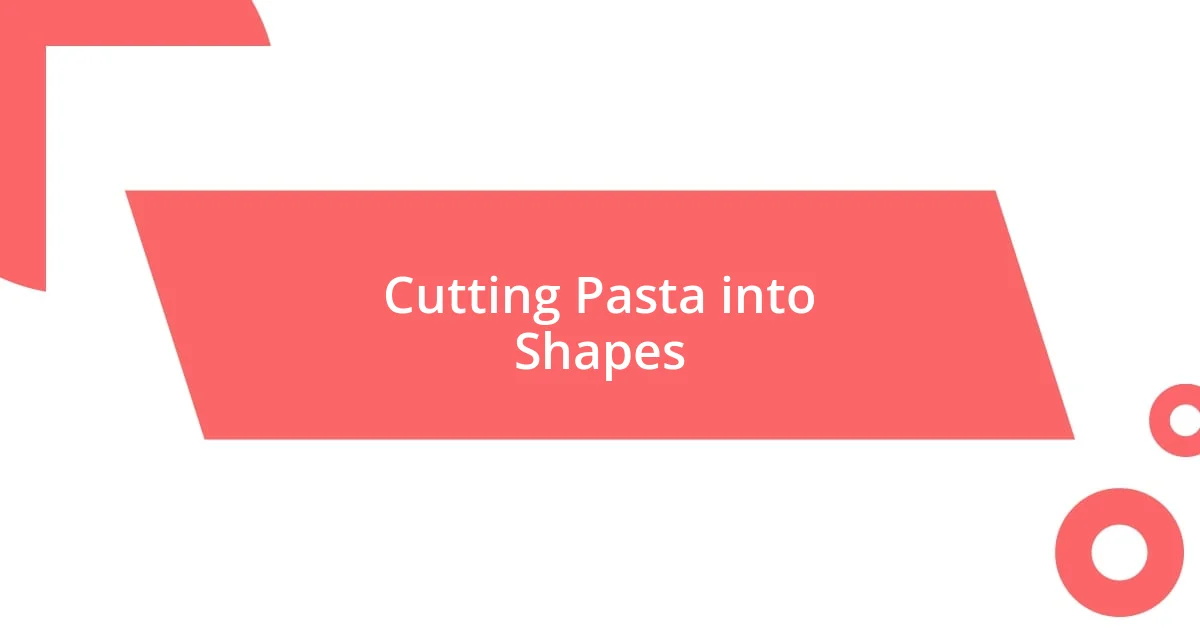Key takeaways:
- Choosing the right flour, such as Italian 00 or semolina, significantly impacts pasta texture and flavor.
- Using high-quality eggs, like free-range or pasture-raised, enhances the taste and quality of homemade pasta.
- Proper mixing, rolling, and cooking techniques, including letting the dough rest and reserving pasta water, are essential for achieving perfect homemade pasta.

Choosing the Right Flour
When it comes to choosing the right flour for homemade pasta, I always lean towards Italian 00 flour for its fine texture and high protein content. It creates a silky dough that rolls out beautifully, making the pasta tender yet firm. Have you ever experienced the delight of rolling out a perfect sheet of pasta? It’s truly satisfying!
However, don’t overlook semolina flour, especially if you want to create pasta with a bit more bite. I remember experimenting with a semolina blend for my first homemade gnocchi. The texture was slightly grainy, but that’s exactly what I was going for—it really gave the dish some character! Can you picture the soft yet sturdy gnocchi soaking up a rich sauce? It elevates the entire meal.
If you’re feeling adventurous, you might even try whole wheat flour for a nuttier flavor and additional fiber. I gave this a shot once when I wanted a healthier option for a family dinner. While the dough was a bit trickier to work with, the end result had a depth of flavor that had everyone asking for seconds! What flour will you choose for your next pasta adventure?

Understanding Egg Types
I’ve often found that the type of eggs I use can significantly impact the flavor and texture of my homemade pasta. For instance, I prefer free-range eggs for their vibrant yolks and richer taste. Whenever I crack one open, the color is like sunshine in my kitchen. Have you ever noticed how different egg colors can inspire you to create? It adds a whole new layer to the cooking experience.
On the other hand, organic eggs are another great option that I’ve occasionally turned to. They might be a bit pricier, but I’ve always felt that the quality justifies the cost. One time, I made a special pasta dish for a gathering using organic eggs, and the compliments kept rolling in. It really highlighted how quality ingredients can elevate even the simplest of recipes.
Lastly, I can’t overlook the allure of pasture-raised eggs. These gems are often hailed for their superior nutrient profile and even richer flavor. I’ll never forget the day I used them for my homemade fettuccine; the result was a pasta so flavorful that I could hardly believe it was made right in my own kitchen. What type of eggs do you think you’ll experiment with next?
| Type of Egg | Description |
|---|---|
| Free-range | Vibrant yolks, rich taste |
| Organic | Higher quality, rich flavor |
| Pasture-raised | Superior nutrients, richer taste |

Mixing the Ingredients Properly
Mixing your ingredients properly is crucial to achieving that perfect pasta dough. I remember the first time I made pasta; I didn’t appreciate the importance of this step and ended up with a dry, crumbly mess. It was a real eye-opener! Now, I always make it a point to mix my flour and eggs gently but thoroughly until they just come together. This ensures that I create a cohesive dough that doesn’t end up too tough or too sticky.
Here’s a quick guide on how to mix your pasta ingredients effectively:
- Use a clean surface: Create a well of flour on a clean countertop for easy mixing.
- Incorporate ingredients slowly: Gradually add your eggs into the flour, mixing with a fork or your fingers, until the dough forms.
- Knead gently: Once mixed, knead the dough for 8-10 minutes until it’s smooth and elastic. This step builds the right texture.
- Let it rest: Allow the dough to rest for at least 30 minutes before rolling it out; this significantly enhances the texture.
- Watch the moisture: If your dough feels too dry, you can add a tiny splash of water or a bit more egg, but do this sparingly!
By following these tips, your pasta-making will be much more enjoyable. Trust me, there’s nothing quite like the satisfaction of creating dough that feels just right in your hands!

Rolling Out the Dough Evenly
Rolling out the dough evenly is a crucial step in homemade pasta making that can really affect your final product. I vividly remember the first time I rolled out my dough; I was so excited that I rushed through it and ended up with one side thick and the other paper-thin. Have you ever had a pasta experience where you realized the difference can be as subtle as how evenly the dough is rolled? It can make a world of difference when cooking!
To ensure an even roll, I’ve adopted the technique of working in stages. I begin by dividing the dough into smaller portions. This way, I can focus on each piece to get it just right. The key is to apply even pressure when rolling, and I often find myself turning the dough a quarter turn after each pass with the rolling pin. This technique not only helps in maintaining an even thickness but also keeps the dough from sticking to the surface. I once got so absorbed in the task that I lost track of time, but the moment I saw the perfect sheet of dough—uniform and smooth—it was worth every minute.
Another tip that I’ve found invaluable is using flour judiciously. I’ve made the mistake of dusting too much flour on the surface, and it created an unnecessary barrier that made rolling arduous. Instead, I sprinkle just enough flour to prevent sticking and keep the dough pliable. Have you ever felt that satisfying stretch of well-rolled dough? When you get that right consistency, the joy is palpable, and it makes the whole pasta-making journey feel like a delightful dance in the kitchen!

Cutting Pasta into Shapes
Cutting pasta into shapes can be one of the most enjoyable parts of the process. I remember when I first tried my hand at making fettuccine; I couldn’t contain my excitement as I rolled out the dough and sliced it into ribbons. There’s something satisfying about transforming a flat sheet of dough into beautiful, delicate pasta shapes. Do you ever find yourself daydreaming about the various shapes you can create? From rustic orecchiette to elegant tagliatelle, each shape has its own character and perfect sauce pairing.
When it comes to cutting, I’ve found that a sharp knife is essential; dull blades can lead to uneven edges. I like to use a pizza cutter for straight cuts—it glides effortlessly through the dough, and makes the whole process quicker. There’s a certain rhythm to it that feels almost meditative. After mastering the classic shapes, I started experimenting with my own designs, sometimes even using cookie cutters for fun. Have you ever tried crafting your own peculiar shapes? It’s an excellent way to unleash your creativity!
Lastly, let’s not overlook the importance of drying your freshly cut pasta before cooking. When I first made large batches, I often tossed them directly into boiling water, only to have them clump together. Now, I make sure to let the pasta dry for at least 20 minutes on a floured surface. This becomes a perfect opportunity to invite friends over for pasta night, as I love sharing this process with others. The laughter, the experimentation, and the delicious outcome are what make homemade pasta truly special. What about you? Do you find joy in sharing your culinary adventures?

Cooking Homemade Pasta Perfectly
Cooking homemade pasta perfectly is an art that takes practice. I still remember the first time I dropped my beautifully shaped pasta into boiling water, only to let out a sigh as they stuck together in a clump. Have you ever felt that heartache when a culinary creation doesn’t go as planned? Timing is absolutely essential; I’ve learned that adding the pasta to water only when it reaches a rolling boil ensures that it cooks evenly and maintains that delightful al dente texture.
While cooking, I pay close attention to the scent of the pasta and the boiling water, a simple but effective technique I adopted over the years. As the timer ticks down, I often find myself taking little tastes—not just for seasoning, but to check the texture. That moment when the pasta is just right? Pure joy! Have you ever savored that first bite of homemade pasta, feeling as if you’re transported to Italy, even if you’re just in your kitchen?
Lastly, don’t forget the importance of reserving some pasta water. I learned this tip the hard way after a delicious sauce got too thick. Now, I always save a cup of that starchy water before draining my pasta. It adds a perfect silkiness to the sauce, binding everything together beautifully. Isn’t it fascinating how a simple ingredient change can elevate a dish? Sharing these little insights and tricks has made my pasta nights feel like a warm gathering, filled with laughter and delicious food. What’s your secret tip for making homemade pasta unforgettable?

Storing Extra Pasta Effectively
Storing extra pasta effectively is crucial for maintaining its freshness. I once made a huge batch of gnocchi and didn’t know how to store them properly. I ended up with a mushy mess that lost all its charm! Now, I always sprinkle a little flour on the extra pieces before placing them in an airtight container. This little trick prevents them from sticking together and keeps their shape. Have you ever faced a similar dilemma with leftover pasta?
If you’re dealing with dried pasta, the key is to keep it in a cool, dry place. I’ve learned that sealing it in a glass or plastic container can extend its shelf life significantly. The last time I forgot about a batch of penne in the pantry, it transformed into a time capsule of flavors! Now, I always label my containers with the date, reminding me to use them before they lose their spark. Don’t you find it satisfying to have everything organized in the kitchen?
For fresh pasta, I usually freeze any leftovers if I know I won’t use them within a couple of days. I remember my first attempt at freezing ravioli; I laid them out on a baking sheet and froze them before transferring them to a bag. The thrill of pulling out those homemade delights weeks later was like finding hidden treasure! Just remember to sprinkle them with flour before freezing to keep them from sticking. Have you discovered a favorite method for preserving your culinary creations?















